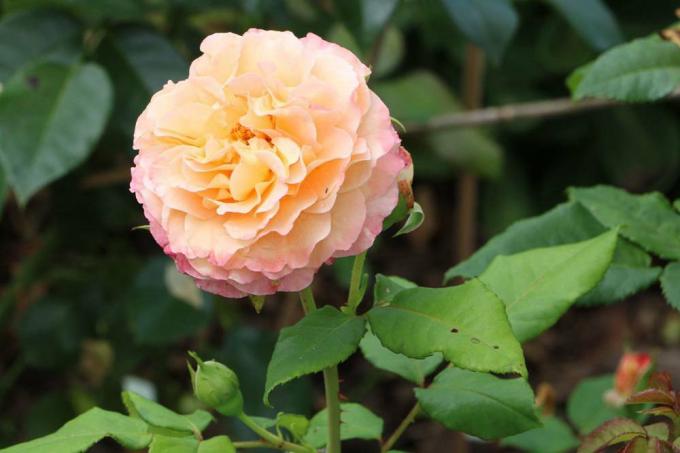
table of contents
- Winter protection
- Wrap up roots
- Pack the crown
- Protect trunk
- Location, care
- Winter in rooms
- Outdoor season
There are countless varieties and colors of roses. They are planted in the bed or cultivated in a tub or pot. Depending on the variety and cultivation, it places more or less high demands on wintering. Bucket and potted roses must be specially protected from the cold and frost, as their roots are not deep in the ground. With a little skill and planning, you can get these roses through the winter well.
Winter protection
Winter protection for the rose
Roses are best overwintered outdoors. For roses that are grown in pots or tubs, the roots, trunk and crown must be protected from frost and cold. Roses can only survive the German winter if they are well packaged. Before you start packing, the roses must first be prepared for it. These preparations begin long before wintering.
- cut off faded and buds
- Cut is made before the first frost
- ideal in late summer or autumn
- remove fallen leaves from the planter
When making this last cut, make sure that the rose plants still have enough time to close the wound. The cut in autumn is not a topiary. It serves to prepare the plant for hibernation. Without leaves and buds, the rose focuses on its roots. You will be strengthened for the winter.

So that the rose can optimally prepare for winter, you should stop fertilizing at the end of July. If it is fertilized later, it will not stop growing and will sometimes start to bloom again. This late bloom delays cutting and consequently wound closure. And before you know it, the first night frost is there. In addition, the shoots do not lignify and the natural protection is lost.
Wrap up roots
A bucket or pot does not protect the rose's roots from the cold. It penetrates the soil from above, below and through the side walls of the planter. The rose roots are therefore exposed to the cold on all sides. If the planter is not packed, the roots will slowly freeze to death or, in the event of sudden frost, very quickly.
A shock occurs:
- The root ball freezes through
- it is best to cover the planter with winter-proof insulating material
- The jacket must be permeable to water and air
- Bubble wrap, coconut mats, jute felt are ideal
Once the roots are protected from the cold that can penetrate through the walls of the planter, they must also be protected from frost and moisture above and below. The cold tends to creep over stones or tiles into the pot, especially from below. You can counteract this by raising the planter to avoid direct contact with the ground.

The following are suitable for this:
- a plant roller
- a styrofoam mat
- a coconut mat
- a thick wooden board
Finally, the roots have to be protected from above. Since you also have to water the potted rose in winter, it is best to use an insulating material that is not too stiff, such as a coconut mat. Attach the cold protection so that the substrate is well covered, but you can also comfortably water the rose without having to unpack it completely.
- An alternative to packing are special planters or sacks made of jute
- put the rose in a sack or a planter
- stuff the gap with bark mulch or dry leaves
If a jute sack is used, it is tied at the top. This means that the substrate does not have to be specially covered. When tying, keep in mind that you may have to water the rose.

Pack the crown
The crown of roses must be protected from temperature fluctuations in winter. Because the change between frost and winter sun, possibly also strong winds, dry out unprotected shoots.
The easiest way to protect the crown of roses from the cold is with a sack. Put this over the crown and tie it at the end. Suitable materials for this are jute or winter fleece. Both materials are air and moisture permeable, so that no humid climate due to condensation can arise below the protection.
The winter protection is ideal if:
- he loosely resp. is loose over the crown
- it can be easily tied at the end
Do not pinch the rose when tying it. Make sure that the processing point is also packed. You can also protect them with a wrapping tape under the hood.
Tip: Special winter fleece hoods make packing easier. Large crowns are easier to wrap up with a zippered coat.
Since foils are neither air nor moisture permeable, they are not suitable as protection for the crown. A damp climate can develop under the foil, which is very attractive to fungi and pests.
Protect trunk
Especially with roses with a tall trunk, cracks can appear in the bark in winter, through which cold and pests can penetrate the plant. You can use mats or wrapping tapes as trunk protection. Suitable materials are jute or winter fleece. There are mats made of straw or reed in specialist shops.

Tip: Wrapping tapes are easier to use than mats. You can also use it to wrap the trunk directly and without any gaps.
Location, care
Location and care during wintering
Sure, a packaged rose doesn't need any maintenance. However, well-intentioned care mistakes can occur.
Therefore:
- only water the tub rose on frost-free days
- very economical watering
- avoid waterlogging
- in no case fertilize
Like the packaging, the correct location also helps the rose to get through the winter unscathed. It is ideal if you can place your rose plants against a house wall. It not only protects the rose from the wind, but also offers it a little warmth. But be careful, too much sun in winter damages the plant. Choose a location with morning or evening sun for wintering. However, avoid a location with blazing midday sun.
Winter in rooms
Hibernate the potted roses indoors
Although the rose is very sensitive to cold temperatures, it prefers to overwinter outside than inside. Nevertheless, you can also overwinter a tub rose indoors.
Ideal locations are:
- basement, cellar
- garage
- cool winter garden
It is important that the temperature in the winter quarters does not drop below zero degrees Celsius. Heated rooms are unsuitable for wintering because the plant does not go into hibernation there. A rose only “hibernates” when it is forced to do so by the weather. That is why the rose does not even think about a blooming or growth break in a heated winter quarter.
Outdoor season
Unpacking, start of the outdoor season
It doesn't matter whether the rose has overwintered inside or outside, it has to slowly get used to the light and sun again. Even a strong March sun can be a shock for the rose.

Therefore, unpack the plant:
- on an overcast day
- without rain
- with mild temperatures
Tip: Since frost and cold cannot always be planned in spring, have the winter protection of the Rose Handle ready. So you can quickly protect the plant again.

